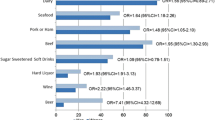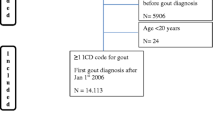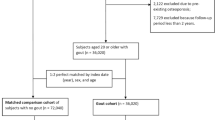Abstract
Gout affects 8.3 million Americans according to NHANES 2007–2008, approximately 3.9 % of the US population. Gout has substantial effect on physical function, productivity, health-related quality of life (HRQOL), and health care costs. Uncontrolled gout is also associated with significant use of emergency care services. Women are less likely to have gout than men, but in the postmenopausal years the gender difference in disease incidence decreases. Compared with whites, racial and/or ethnic minorities, especially blacks, have higher prevalence of gout. Blacks are also less likely to receive quality gout care, leading to disproportionate morbidity. Women are less likely than men to receive allopurinol, and less likely to undergo joint aspirations for crystal analysis to establish diagnosis, but those on urate-lowering therapy are as likely as, or more likely than, men to undergo serum urate check within six months of initiation. Although a few studies provide the knowledge related to gender and race and/or ethnicity disparities for gout, several knowledge gaps exist in gout epidemiology and outcomes differences by gender and race and/or ethnicity. These should be investigated in future studies.

Similar content being viewed by others
References
Papers of particular interest, published recently, have been highlighted as: • Of importance •• Of major importance
Kimball MM, Neal D, Waters MF, Hoh BL. Race and income disparity in ischemic stroke care: nationwide inpatient sample database, 2002 to 2008. J Stroke Cerebrovasc Dis Off J Natl Stroke Assoc. Jul 17 2012
Wellons MF, Fujimoto VY, Baker VL, et al. Race matters: a systematic review of racial and/or ethnic disparity in Society for Assisted Reproductive Technology reported outcomes. Fertil Steril. 2012;98(2):406–9.
Sclar DA, Robison LM, Schmidt JM, Bowen KA, Castillo LV, Oganov AM. Diagnosis of depression and use of antidepressant pharmacotherapy among adults in the United States: does a disparity persist by ethnicity/race? Clin Drug Investig. 2012;32(2):139–44.
Kreatsoulas C, Anand SS. Disparity in outcomes of surgical revascularization for limb salvage. Race and gender are synergistic determinants of vein graft failure and limb loss. Nguyen LL, Hevelone N, Rogers SO, Bandyk DF, Clowes AW, Moneta GL, Lipsitz S, Conte MS. Circulation. 2009; 119: 123–130. Vasc Med. Nov 2009;14(4):397–399
Lam BL, Lee DJ, Zheng DD, Davila EP, Christ SL, Arheart KL. Disparity in prevalence of self-reported visual impairment in older adults among U.S. race-ethnic subgroups. Ophthalmic Epidemiol. 2009;16(3):144–50.
Tomson CR, Foley RN, Li Q, Gilbertson DT, Xue JL, Collins AJ. Race and end-stage renal disease in the United States Medicare population: the disparity persists. Nephrology (Carlton). 2008;13(7):651–6.
Hlaing WM. Race/ethnic disparity in hypertension-related hospitalization in Florida. Ethn Dis. 2007;17(3):453–60.
Chang KJ, Parasher G, Christie C, Largent J, Anton-Culver H. Risk of pancreatic adenocarcinoma: disparity between African Americans and other race/ethnic groups. Cancer 2005;103(2):349–57.
Hawker GA. The quest for explanations for race/ethnic disparity in rates of use of total joint arthroplasty. J Rheumatol. 2004;31(9):1683–5.
Wenger NS, Pearson ML, Desmond KA, et al. Epidemiology of do-not-resuscitate orders. Disparity by age, diagnosis, gender, race, and functional impairment. Arch Intern Med. 1995;155(19):2056–62.
Cox ED, Nackers KA, Young HN, Moreno MA, Levy JF, Mangione-Smith RM. Influence of race and socioeconomic status on engagement in pediatric primary care. Patient Educ Couns. 2012;87(3):319–26.
Yao L, Robert SA. Examining the racial crossover in mortality between African American and White Older adults: a multilevel survival analysis of race, individual socioeconomic status, and neighborhood socioeconomic context. J Aging Res. 2011;2011:132073.
Chu DI, Moreira DM, Gerber L, et al. Effect of race and socioeconomic status on surgical margins and biochemical outcomes in an equal-access health care setting: Results from the Shared Equal Access Regional Cancer Hospital (SEARCH) database. Cancer. Mar 13 2012
Trinh QD, Sun M, Sammon J, et al. Disparities in access to care at high-volume institutions for uro-oncologic procedures. Cancer. Feb 1 2012
FitzGerald JD, Soohoo NF, Losina E, Katz JN. Potential impact on patient residence to hospital travel distance and access to care under a policy of preferential referral to high-volume knee replacement hospitals. Arthritis Care Res. 2012;64(6):890–7.
Langford AT, Resnicow K, Roberts JS, Zikmund-Fisher BJ. Racial and ethnic differences in direct-to-consumer genetic tests awareness in HINTS 2007: sociodemographic and numeracy correlates. J Genet Couns. 2012;21(3):440–7.
Cene CW, Roter D, Carson KA, Miller 3rd ER, Cooper LA. The effect of patient race and blood pressure control on patient–physician communication. J Gen Intern Med. 2009;24(9):1057–64.
Gordon HS, Street Jr RL, Kelly PA, Souchek J, Wray NP. Physician–patient communication following invasive procedures: an analysis of post-angiogram consultations. Soc Sci Med. 2005;61(5):1015–25.
Johnson RL, Roter D, Powe NR, Cooper LA. Patient race and/or ethnicity and quality of patient–physician communication during medical visits. Am J Public Health. 2004;94(12):2084–90.
Manfredi C, Kaiser K, Matthews AK, Johnson TP. Are racial differences in patient–physician cancer communication and information explained by background, predisposing, and enabling factors? J Heal Commun. 2010;15(3):272–92.
Jeon-Slaughter H. Economic factors in of patients’ nonadherence to antidepressant treatment. Soc Psychiatry Psychiatr Epidemiol. Mar 14 2012
Byrne MM, Souchek J, Richardson M, Suarez-Almazor M. Racial and/or ethnic differences in preferences for total knee replacement surgery. J Clin Epidemiol. 2006;59(10):1078–86.
Rosen AB, Tsai JS, Downs SM. Variations in risk attitude across race, gender, and education. Med Dec Making Int J Soc Med Dec Making. 2003;23(6):511–7.
Ibrahim SA, Siminoff LA, Burant CJ, Kwoh CK. Differences in expectations of outcome mediate African American/white patient differences in “willingness” to consider joint replacement. Arthritis Rheum. 2002;46(9):2429–35.
Hofmann JC, Wenger NS, Davis RB, et al. Patient preferences for communication with physicians about end-of-life decisions. SUPPORT Investigators. Study to understand prognoses and preference for outcomes and risks of treatment. Ann Intern Med. 1997;127(1):1–12.
Whittle J, Conigliaro J, Good CB, Lofgren RP. Racial differences in the use of invasive cardiovascular procedures in the Department of Veterans Affairs medical system. N Engl J Med. 1993;329(9):621–7.
Constantinescu F, Goucher S, Weinstein A, Fraenkel L. Racial disparities in treatment preferences for rheumatoid arthritis. Med Care. 2009;47(3):350–5.
Unequal Treatment: Confronting Racial and Ethnic Disparities in Health Care (full printed version). Committee on Understanding and Eliminating Racial and Ethnic Disparities in Health Care. ISBN: 0-309-50911-4, 782 pages, 6 × 9, (2003). http://www.nap.edu/catalog/10260.html. 2003
Nelson A. Unequal treatment: confronting racial and ethnic disparities in health care. J Natl Med Assoc. 2002;94(8):666–8.
Nelson AR. Unequal treatment: report of the Institute of Medicine on racial and ethnic disparities in healthcare. Ann Thorac Surg. 2003;76(4):S1377–1381.
Institute of Medicine. 100 Initial Priority Topics for Comparative Effectiveness Research. http://www.iom.edu/~/media/Files/Report Files/2009/ComparativeEffectivenessResearchPriorities/Stand Alone List of 100 CER Priorities - for web.pdf. 2009
Cartwright-Smith L, Rosenbaum S, Mehta D. Disparities Reduction and Minority Health Improvement under the ACA. Vol 3. Washington, D.C.: The George Washington University School of Public Health and Health Services; 2011:1–6
Notice Number: NOT-HS-11-013. Special Emphasis Notice (SEN): AHRQ Announces Interest in Grants focused on Health Issues of Minority Women. Release Date: April 13, 2011. http://grants.nih.gov/grants/guide/notice-files/NOT-HS-11-013.html. 2011
Birnie D, Tung S, Simpson C, et al. Complications associated with defibrillation threshold testing: the Canadian experience. Heart Rhythm Off J Heart Rhythm Soc. 2008;5(3):387–90.
Curtis LH, Al-Khatib SM, Shea AM, Hammill BG, Hernandez AF, Schulman KA. Sex differences in the use of implantable cardioverter-defibrillators for primary and secondary prevention of sudden cardiac death. JAMA. 2007;298(13):1517–24.
Hernandez AF, Fonarow GC, Liang L, et al. Sex and racial differences in the use of implantable cardioverter-defibrillators among patients hospitalized with heart failure. JAMA. 2007;298(13):1525–32.
Kaul P, Chang WC, Westerhout CM, Graham MM, Armstrong PW. Differences in admission rates and outcomes between men and women presenting to emergency departments with coronary syndromes. CMAJ. 2007;177(10):1193–9.
Bierman AS, Pugh MJ, Dhalla I, et al. Sex differences in inappropriate prescribing among elderly veterans. Am J Geriatr Pharmacother. 2007;5(2):147–61.
Institute of Medicine. Women’s Health Research: Progress, Pitfalls, and Promise. 9/23/2010. http://www.iom.edu/Reports/2010/Womens-Health-Research-Progress-Pitfalls-and-Promise/Report-Brief.aspx. 2010. Accessed 07/18/2012
Healthcare Quality and Disparities in Women: Selected Findings From the 2010 National Healthcare Quality and Disparities Reports. Fact Sheet. AHRQ Publication No. 11-0005-1-EF, March 2011. http://www.ahrq.gov/qual/nhqrwomen/nhqrwomen.htm. 2011. Accessed 08/05/2012
•• Zhu Y, Pandya BJ, Choi HK. Prevalence of gout and hyperuricemia in the US general population: the National Health and Nutrition Examination Survey 2007–2008. Arthritis Rheum. 2011;63(10):3136–41. This is the first comprehensive population-based epidemiological study of the prevalence of gout in the US general population.
Helmick CG, Felson DT, Lawrence RC, et al. Estimates of the prevalence of arthritis and other rheumatic conditions in the United States. Part I. Arthritis Rheum Jan. 2008;58(1):15–25.
Singh JA, Strand V. Gout is associated with more comorbidities, poorer health-related quality of life and higher healthcare utilisation in US veterans. Ann Rheum Dis. 2008;67(9):1310–6.
Edwards NL, Sundy JS, Forsythe A, Blume S, Pan F, Becker MA. Work productivity loss due to flares in patients with chronic gout refractory to conventional therapy. J Med Econ. 2011;14(1):10–5.
Kleinman NL, Brook RA, Patel PA, et al. The impact of gout on work absence and productivity. Value Health. 2007;10(4):231–7.
Roddy E, Zhang W, Doherty M. Is gout associated with reduced quality of life? A case–control study. Rheumatology (Oxford). 2007;46(9):1441–4.
Khanna D, Ahmed M, Yontz D, et al. The disutility of chronic gout. Qual Life Res. 2008;17(5):815–22.
Krishnan E, Baker JF, Furst DE, Schumacher HR. Gout and the risk of acute myocardial infarction. Arthritis Rheum. 2006;54(8):2688–96.
•• De Vera MA, Rahman MM, Bhole V, Kopec JA, Choi HK. Independent impact of gout on the risk of acute myocardial infarction among elderly women: a population-based study. Ann Rheum Dis. 2010;69(6):1162–4. This is a high-quality cohort study assessing gout as a risk factor for cardiac outcomes.
Krishnan E, Svendsen K, Neaton JD, Grandits G, Kuller LH, Group MR. Long-term cardiovascular mortality among middle-aged men with gout. Arch Intern Med. 2008;168(10):1104–10.
•• Krishnan E. Gout and the risk for incident heart failure and systolic dysfunction. BMJ Open. 2012;2(1):e000282. This high-quality cohort study established a link between gout and heart failure.
Cohen SD, Kimmel PL, Neff R, Agodoa L, Abbott KC. Association of incident gout and mortality in dialysis patients. J Am Soc Nephrol. 2008;19(11):2204–10.
• Charles BA, Shriner D, Doumatey A, et al. A genome-wide association study of serum uric acid in African Americans. BMC Med Genomics. 2011;4:17. This study highlights the genetic correlates of serum uric acid in minorities.
Rule AD, de Andrade M, Matsumoto M, Mosley TH, Kardia S, Turner ST. Association between SLC2A9 transporter gene variants and uric acid phenotypes in African American and white families. Rheumatology (Oxford). 2011;50(5):871–8.
Hochberg MC, Thomas J, Thomas DJ, Mead L, Levine DM, Klag MJ. Racial differences in the incidence of gout. The role of hypertension. Arthritis Rheum. 1995;38(5):628–32.
Maynard JW, McAdams Demarco MA, Baer AN, et al. Incident Gout in Women and Association with Obesity in the Atherosclerosis Risk in Communities (ARIC) study. Am J Med. 2012;125(7):717 e719–7.
Portis AJ, Laliberte M, Tatman P, et al. High prevalence of gouty arthritis among the Hmong population in Minnesota. Arthritis Care Res (Hoboken). 2010;62(10):1386–91.
Wahedduddin S, Singh JA, Culhane-Pera KA, Gertner E. Gout in the Hmong in the United States. J Clin Rheumatol. 2010;16(6):262–6.
Rose BS. Gout in Maoris. Semin Arthritis Rheum. 1975;5(2):121–45.
Stanhope JM, Prior IA. Uric acid, joint morbidity, and streptococcal antibodies in Maori and European teenagers. Rotorua Lakes study 3. Ann Rheum Dis. 1975;34(4):359–63.
•• Juraschek SP, Miller 3rd ER, Gelber AC. Body mass index, obesity, and prevalent gout in the United States in 1988–1994 and 2007–2010: body mass index, obesity, and gout. Arthritis Care Res (Hoboken). 2012. This study used NHANES data and described the association between obesity and prevalent gout over time.
Phipps-Green AJ, Hollis-Moffatt JE, Dalbeth N, et al. A strong role for the ABCG2 gene in susceptibility to gout in New Zealand Pacific Island and Caucasian, but not Maori, case and control sample sets. Hum Mol Genet. 2010;19(24):4813–9.
Hall AP, Barry PE, Dawber TR, McNamara PM. Epidemiology of gout and hyperuricemia. A long-term population study. Am J Med Jan. 1967;42(1):27–37.
Arromdee E, Michet CJ, Crowson CS, O’Fallon WM, Gabriel SE. Epidemiology of gout: is the incidence rising? J Rheumatol. 2002;29(11):2403–6.
Currie WJ. Prevalence and incidence of the diagnosis of gout in Great Britain. Ann Rheum Dis. 1979;38(2):101–6.
Harris CM, Lloyd DC, Lewis J. The prevalence and prophylaxis of gout in England. J Clin Epidemiol. 1995;48(9):1153–8.
Grodzicki T, Palmer A, Bulpitt CJ. Incidence of diabetes and gout in hypertensive patients during 8 years of follow-up. The General Practice Hypertension Study Group. J Hum Hypertens Sep. 1997;11(9):583–5.
De Souza AW, Fernandes V, Ferrari AJ. Female gout: clinical and laboratory features. J Rheumatol. 2005;32(11):2186–8.
Akizuki S. A population study of hyperuricaemia and gout in Japan—analysis of sex, age and occupational differences in thirty-four thousand people living in Nagano Prefecture. Ryumachi [Rheumatism]. 1982;22(3):201–8.
Chen JH, Yeh WT, Chuang SY, Wu YY, Pan WH. Gender-specific risk factors for incident gout: a prospective cohort study. Clin Rheumatol. 2012;31(2):239–45.
Kolz M, Johnson T, Sanna S, et al. Meta-analysis of 28,141 individuals identifies common variants within five new loci that influence uric acid concentrations. PLoS Genet Jun. 2009;5(6):e1000504.
Kang HR, Jee YK, Kim YS, et al. Positive and negative associations of HLA class I alleles with allopurinol-induced SCARs in Koreans. Pharmacogenet Genomics. 2011;21(5):303–7.
Wells AF, MacDonald PA, Chefo S, Jackson RL. African American patients with gout: efficacy and safety of febuxostat vs allopurinol. BMC Musculoskelet Disord. 2012;13:15.
Khosravan R, Kukulka MJ, Wu JT, Joseph-Ridge N, Vernillet L. The effect of age and gender on pharmacokinetics, pharmacodynamics, and safety of febuxostat, a novel nonpurine selective inhibitor of xanthine oxidase. J Clin Pharmacol. 2008;48(9):1014–24.
Singh JA, Hodges JS, Toscano JP, Asch SM. Quality of care for gout in the US needs improvement. Arthritis Rheum. 2007;57(5):822–9.
Krishnan E, Lienesch D, Kwoh CK. Gout in ambulatory care settings in the United States. J Rheumatol. 2008;35(3):498–501.
Solomon DH, Avorn J, Levin R, Brookhart MA. Uric acid lowering therapy: prescribing patterns in a large cohort of older adults. Ann Rheum Dis. 2008;67(5):609–13.
Harrold LR, Yood RA, Mikuls TR, et al. Sex differences in gout epidemiology: evaluation and treatment. Ann Rheum Dis. 2006;65(10):1368–72.
Singh JA. Can racial disparities in optimal gout treatment be reduced? Evidence from a randomized trial. BMC Med. 2012;10:15.
Acknowledgments
Dr Singh is supported by research grants from the National Institute of Aging, the National Cancer Institute, the National Institute of Arthritis and Musculoskeletal Diseases, the Agency for Health Quality, and the Research Center for Education and Research on Therapeutics, and by the resources and facilities at the Birmingham VA Medical Center, Alabama, USA. The views expressed in this article are those of the author and do not necessarily reflect the position or policy of the Department of Veterans Affairs or the United States government.
Disclosure
Dr Singh has received research grants from Takeda and Savient and consultant fees from Savient, Takeda, Ardea, Regeneron, Allergan, URL Pharmaceuticals, and Novartis. Dr Singh is a member of the executive of OMERACT (an organization that develops outcome measures in rheumatology and receives arms-length funding from 36 companies), a member of the American College of Rheumatology’s Guidelines Subcommittee of the Quality of Care Committee, and a member of the Veterans Affairs Rheumatology Field Advisory Committee.
Author information
Authors and Affiliations
Corresponding author
Additional information
This article is part of the Topical Collection on Crystal Arthritis
Rights and permissions
About this article
Cite this article
Singh, J.A. Racial and Gender Disparities Among Patients with Gout. Curr Rheumatol Rep 15, 307 (2013). https://doi.org/10.1007/s11926-012-0307-x
Published:
DOI: https://doi.org/10.1007/s11926-012-0307-x




